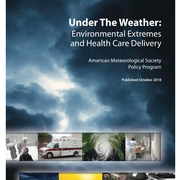Download Report
Executive Summary
Severe weather is a necessary product of the natural environment. Storms, though sometimes powerful and deadly, are nature’s temperature and moisture balancing mechanisms. We know this with great certainty. We also know that the United States experiences as much or more severe weather than any other country on Earth. And, we are also increasingly informed that a changing climate may intensify the storms that already frequent our coasts and rip through our rural and urban areas on a seasonal or annual timeframe.
Despite this accumulated awareness, the United States’ critical infrastructure, most specifically hospital infrastructure, remains unprotected against the expected movements of our natural environment. In April 2007, the American Meteorological Society (AMS) hosted a forum titled “Under the Weather: Environmental Extremes and Health Care Delivery” to spotlight severe weather vulnerabilities to hospitals and to healthcare continuity.
For one and one-half days in the Ronald Reagan Building in Washington, D.C., more than 50 leading federal and local-level decision-makers, who represented a diverse range of disciplines (e.g., public health, meteorology, hospital administration, engineering, and state emergency management), met to discuss what is needed to improve structural preparedness for hospital buildings, the people who staff them, and the people who need them.
Together, we discovered three overarching policy problems that are barriers to preparedness for hospitals and the continuity of healthcare delivery. There is a general lack of awareness of environmental vulnerabilities on the part of local decision makers. Another is the absence of coordination and communication across federal agencies. And, finally, a paucity of financial resources or incentives that could encourage needed structural mitigation or adaptation for current and projected weather risks.
We focused on creating communication and coordination channels because they were so central to tackling the other problems. Namely, new channels could produce products and tools that inform hospital decision-makers about environmental risks to their facilities. Additionally, new channels could open financial opportunities (e.g., grants or subsidies) that make it possible to implement engineering and meteorological solutions. The only trouble is that these channels are presently absent across federal agencies and between federal and private organizations.
As we addressed possible solutions to each, we also realized one common thread—that the science, engineering, and emergency management solutions needed to protect these critical infrastructures and to promote continuity of operations already exist. Several agencies and private companies already have major pieces of the puzzle in place. These pieces, however, tend to be locked within organizations, either in storage (literally) or used for a purpose that is more narrow than its potential (e.g., GIS-applications that could convey location-specific weather forecasts).
The forum, and this report, each addressed the potential policy and financial game changers that are needed to unlock, dust off, or expand existing products and services for hospital and healthcare preparedness against known and probable weather risks. The “Under the Weather” forum was the first in a series of such discussions. With our federal, private, and non-governmental partners we held subsequent forums on this topic. These discussions delve into the available federal programs and services, and private/public partnerships opportunities. We come from diverse fields and are unified for a single purpose, which is to tap the available potential in this nation to protect the only infrastructure that provides for our health, and is a major piece of the engine that keeps the nation moving.
